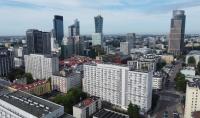How to decarbonise Warsaw's buildings?

As part of the project, three selected Warsaw buildings underwent a comprehensive analysis, photo: pixabay
For nearly two years, students from the Warsaw University of Technology have been working on decarbonization plans for Warsaw. The plans have been developed and presented. Now is the time to implement them.
The solutions were developed as part of the New Generation Engineers project – a collaborative initiative of the Warsaw University of Technology, the Capital City of Warsaw, the Embassy of Denmark in Warsaw, and Danfoss Poland. Such collaboration was supposed to yield a tangible result – an idea of what should be done in the capital to enhance building energy efficiency and reduce carbon dioxide emissions. The solutions already implemented in Denmark served as a model for Warsaw. To get to know them well, the WUT's delegation visited locations where technologies for cities of the future are at the forefront. These places included UrbanRigger housing on the water and the Nordhavn area in Copenhagen, the campus of the University of Sonderborg, and the Danfoss headquarters in Nordborg.
What are those plans?
Students from the Warsaw University of Technology organized into three interdisciplinary groups, conducted comprehensive analyses on three selected buildings in Warsaw with different ages and characteristics. These were multi-family residential structures, consisting of two pre-war buildings in Warsaw's municipal resources (one in Praga Południe, and the other in Śródmieście, featuring a historic façade), and a recently constructed building in Mokotów under community management.
The developed plans include an assessment of the building's current condition, a technical description of the building, a thermal imaging report, energy consumption regulations, and a description of the methodology. The students presented proposals for improvements regarding building envelope, central heating and domestic hot water installations, adaptation to climate change, as well as architectural and environmental aspects. Among the effects of the introduced improvements are reductions in energy consumption and emissions, costs, improvements in district heating networks, and project scaling.
14 students and 3 researchers from Warsaw University of Technology participated in the New Generation Engineers project. Students represented three faculties: Civil Engineering, Architecture and Building Services, Hydro and Environmental Engineering.
What comes next?
The developed plans were submitted to the authorities of Warsaw and the Municipal Services Boards. They were also presented in the Kamień educational pavilion.
– The developments will be put into practice – says Szymon Firląg, PhD, DSc. from the Faculty of Civil Engineering, who led the project activities at our University. – Warsaw will benefit from the effects of the project during the implementation of initiatives in the NEEST project, as part of the "100 Climate-Neutral and Smart Cities by 2030 Mission."
The official completion of the New Generation Engineers project took place on July 3, 2023, at the Danfoss headquarters. It was an opportunity to summarize the results, award the participants with commemorative diplomas and visit the new net zero emissions factory.








